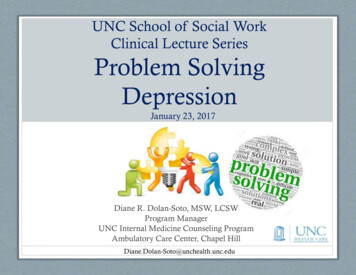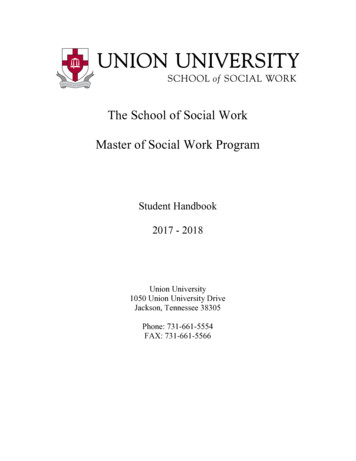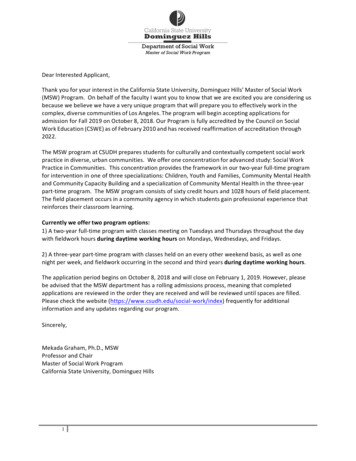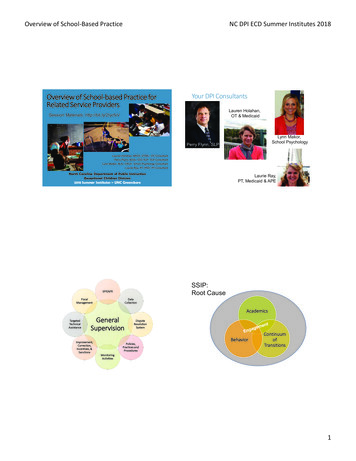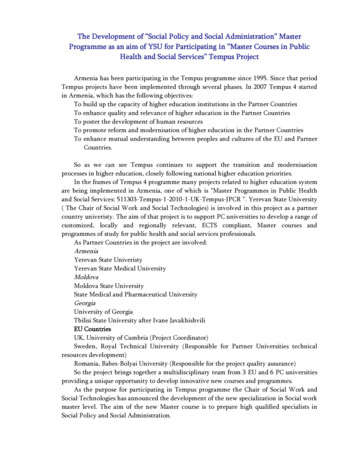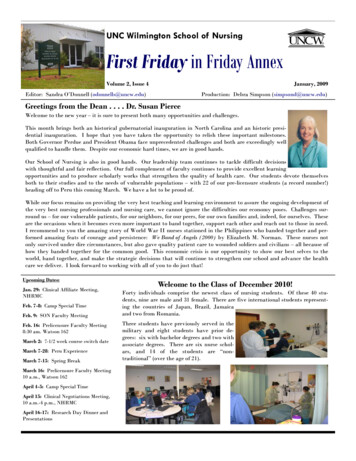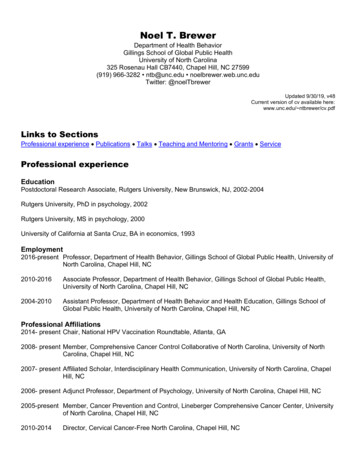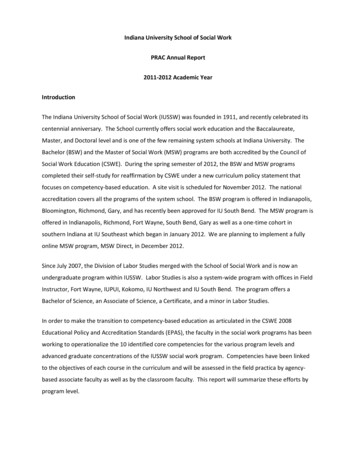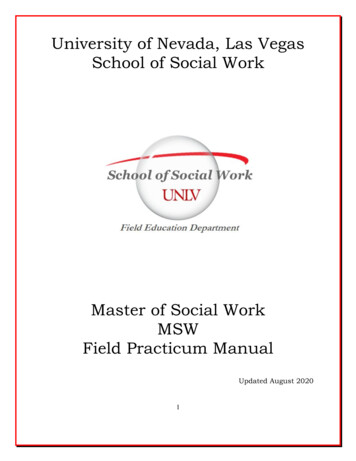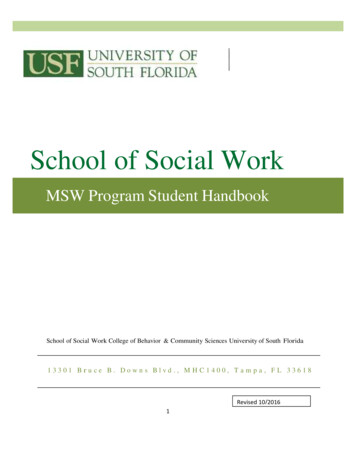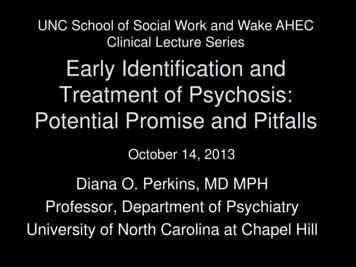
Transcription
UNC School of Social Work and Wake AHECClinical Lecture SeriesEarly Identification andTreatment of Psychosis:Potential Promise and PitfallsOctober 14, 2013Diana O. Perkins, MD MPHProfessor, Department of PsychiatryUniversity of North Carolina at Chapel Hill
Natural Course ofSchizophreniaPremorbidstageAGE10Prodromal Active Remissionphasephase ntUndetected/untreatedillnessHales RE, et al, eds. Textbook of Psychiatry. 5th ed. Arlington, VA: American Psychiatric Publishing; 2008.
Natural Course ofSchizophreniaPremorbidstageAGE10Prodromal Active Remissionphasephase ntUndetected/untreatedillnessHales RE, et al, eds. Textbook of Psychiatry. 5th ed. Arlington, VA: American Psychiatric Publishing; 2008.
Vulnerability and Course– Ratio of men to women withschizophrenia: 1.4– Sex differences in: Age of onsetPremorbid functionSeverity of negative symptomsStructural brain abnormalitiesSubstance useAleman A, et al. Arch Gen Psychiatry. 2003;60(6):565-571.
Age of Schizophrenia Onsetin Males and FemalesAbel KM, et al. Int Rev Psychiatry. 2010;22(5):417-428.
Premorbid Characteristics:Predicting Risk of Schizophrenia– Intellectual abnormalities– Impairments in cognitive function– Socially awkward– Impulsive– Minor physical anomaliesWalker EF, et al. Am J Psychiatry. 1993;150(11):1654-1660; Davidson M, et al. Am J Psychiatry. 1999;156(9):1328-1335.
Premorbid Intellectual FunctioningDavidson M, et al. Am J Psychiatry. 1999;156(9):1328-1335.
Premorbid Social FunctioningDavidson M, et al. Am J Psychiatry. 1999;156(9):1328-1335.
Factors Associated withOutcomes: Premorbid Stage– Sex (male)– Poor premorbid function Delayed developmental milestones Poor academic performance Few friends “Odd”Isohanni M, et al. Br J Psychiatry Suppl. 2005;48:S4-S7.
Pre-morbid functioning inSchizophrenia Patients often have a historyof:– Poor scholastic achievements– Few friends– Psychiatric symptoms BUT: More patients have a history of averagepre-morbid functioning, hence can wepredict/delay/prevent schizophrenia basedon pre-morbid functioning ?
Meet Michael and RyanMichaelRyan “Normal” childhooddevelopment Normal childhooddevelopment Good student untilsecond semesterjunior year in highschool, where hestruggles academically Elite high schoolathlete, “A” student Shy, with few friends Talented musically Popular, social Heads off to college,a highly recruiteddivision 1 athlete
Natural Course ofSchizophreniaPremorbidstageAGE10Prodromal Active Remissionphasephase ntUndetected/untreatedillnessHales RE, et al, eds. Textbook of Psychiatry. 5th ed. Arlington, VA: American Psychiatric Publishing; 2008.
“Prodromal” Characteristics Attenuated Psychosis– Ideas of reference / suspiciousness /unusual thought content– Perceptual abnormalities– Disorganized speech– DerealizationBrief, Intermittent PsychosisNegative Symptoms– Emotional / affective blunting– Diminished drive / motivation– Social withdrawalAffective– Depression/anxiety/hostility– Mood lability– Sub-threshold obsessive compulsive symptomsLieberman JA, et al, eds. Essentials of Schizophrenia. Arlington, VA: American Psychiatric Association; 2012.
Initial “Prodromal” Symptoms Cognitive– Poor attention/distractibility– Impairment initiation or train of thought; intrusive thoughts– Difficulty in understanding written or spoken language Behavioral Disturbances– Decline in school function– Social withdrawal– Impaired hygiene– Sleep disturbance– Suicidal ideation / attempts– Aggressive behaviorsLieberman JA, et al, eds. Essentials of Schizophrenia. Arlington, VA: American Psychiatric Association; 2012.
Attenuated Psychosis Syndrome Characteristic symptoms: at least one of the following inattenuated form with intact reality testing, but of sufficientseverity and/or frequency so as to be beyond normalvariation: (i) delusions (unusual thought content) (ii) hallucinations (perceptual abnormalities) (iii) disorganization (disorganized communication) Present in past monthOccur at least 1 per weekBegun or worsened in past yearDistressing or significantly impact functionNot caused by another disorder (eg, PTSD)Never met criteria for a psychotic disorderAmerican Psychiatric Association: DSM-5. Arlington, VA: American Psychiatric Association; 2013.
Unusual Thought Content– Examples Ideas of reference Sense “something odd is going on” Overvalued beliefs Magical thinking Connections between unrelated event Déjà vu Coincidences Suspiciousness/paranoia Distorted illogical ideas– “prodromal” sense of doubt , may be dismissed– psychotic sure is true, cannot be dismissed
Thought ContentAttenuated DelusionA 15-year-old high schoolstudent sits in the back of theclass because if she sits inthe front, she has anuncomfortable feeling thatother students are watchingher. She knows this is “silly”,but feels better in the back.DelusionA 15-year-old high schoolstudent believes that otherpeople are talking about herand making fun of her whereever she goes. She is surethis is happening, and she isisolating herself at homebecause she is uncomfortablein public.Lieberman JA, et al, eds. Essentials of Schizophrenia. Arlington, VA: American Psychiatric Association; 2012.
Perceptual Disturbances– Examples Illusions Heightened or dulled perceptions Distortions Transient hallucinations– “prodromal” understood as “mind playing tricks”– psychotic certain is a real experience
Perceptual DisturbancesAttenuated HallucinationAbout 2 or 3 times a weeka 22-year-old cashier seesshadows, movements, andsometimes formed figures (likean animal) out of the corner ofhis eye, but when he turns tolook nothing is there. He hearsbeeping sounds that can last forminutes, and once he heard amomentary (a second or two),faint, unintelligible voice. He isnot sure, but thinks it is his mindplaying tricks on him.HallucinationOn a daily basis a 22-year-oldcashier sees fully formed figuresthat he calls “shadows”. Theshadows remain for minutes tohours. He hears the “shadows”speak to each other about him,and sometimes criticize him or tellhim to do something silly. Hebelieves these shadows are realand he is frightened of them.Lieberman JA, et al, eds. Essentials of Schizophrenia. Arlington, VA: American Psychiatric Association; 2012.
Disorganized thoughts/speech– Examples Odd speech, vague, metaphorical, overelaborate Circumstantial, tangential, not goal directed Redirected through structured questioning– “prodromal” can be redirected– psychotic not responsive to structuring, disorganizedwhen minimal pressure
DisorganzationAttenuatedDisorganized SpeechA formerly high achieving high schooljunior reports his friends have greatdifficulty following him when heexplains things to them. This is veryfrustrating to him. During the interviewhe had difficulty getting to the pointand at times his statements did notanswer the question asked. Throughdirect and structured questioning hewas able to answer the questionscorrectly. He did not have this problema year ago, and it is getting worsethese last few months.Psychotic IntensityDisorganized SpeechA formerly high achieving highschool junior is unable to attendschool due to disorganization. Hecan engage in goal directed speechonly when the conversation is highlystructured. His speech often doesn’tmake sense due to looseassociations.Lieberman JA, et al, eds. Essentials of Schizophrenia. Arlington, VA: American Psychiatric Association; 2012.
Survival Distribution FunctionValidity of the Attenuated PsychosisSyndrome CriteriaDays Since Baseline AssessmentRisk Estimates in Persons Meeting APS Criteria:20–25% in 1 year30–35% in 2 yearsWoods SW, et al. Schizophr Bull. 2009;35(5):894-908; Cannon TD, et al. Arch Gen Psychiatry. 2008;65(1):28-37; LiuCC, et al. Schizophr Res. 2011;126(1-3):65-70; Fusar-Poli P, et al. Arch Gen Psychiatry. 2012;69(3):220-229.
Diagnosis at 1 Year Follow-Up for Patientswith Attenuated Psychosis Syndrome25%No axis 1 Dx35%Psychoticdisorder40%Major depression,social phobia,OCD, adjustment,eating disorderWoods SW, et al. Schizophr Bull. 2009;35(5):894-908.
Symptoms Most Predictive of Psychosis Unusual thought content/suspiciousness/distorted ideas Reduced ideational richness Trouble with focus and attention
Reduced Ideational Richness– Examples Unable to make sense of familiar phrases Difficulty getting “gist of conversation” Decreased fluidity, spontaneity, flexibility of thinking Difficulty with abstract thinking Poverty content
Trouble with Focus/Attention– Examples Failure in focused alertness/poor concentration Distractible Difficulty shifting focus Loses tract of conversations
Case 1Max is a 21 y.o. art student at a local college, living in an apartment with afriend from HS. He is close to his parents, who live about ½ hour away. Hisgirlfriend attends the same college, and they spend a lot of time together.Both enjoy smoking marijuana several times a week, but do not think theyhave a problem with it. Max is a gifted artist and has a 3.0 GPA.At 16, Max saw his best friend die in a skiing accident, which was extremelytraumatic. Periodically during the past five years he has had nightmares.Max never went to therapy afterwards, but through the years has talkedabout the accident with family and friends.Lately, Max has been feeling anxious and overwhelmed by his course load.Last night he told his girlfriend that he has been hearing his name calledperiodically for the past several months, but when he checks, no one hasbeen calling him. He’s also finding it uncomfortable to be in crowds andworries that people are looking at him when out in public. He wonders if thisis due to fatigue or smoking pot. Max is bothered by these experiences, andhis girlfriend is encouraging him to see someone at the school counselingservice. He agrees to see a counselor, who then wonders Is Max developing a psychotic disorder?
Case 1 - Max What symptoms are you concernedabout? What diagnoses are you considering? What recommendations do you have?
Case 1Max is a 21 y.o. art student at a local college, living in an apartment with afriend from HS. He is close to his parents, who live about ½ hour away. Hisgirlfriend attends the same college, and they tend to spend a lot of timetogether. Both enjoy smoking marijuana several times a week, but do notthink they have a problem with it. Max is a gifted artist and has a 3.2 GPA.When 16, Max saw his best friend die in a skiing accident, which wastraumatic. Periodically during the past five years he has had nightmares.Max never went to therapy, but has talked about the accident with family andfriends.Lately, Max is feeling anxious and overwhelmed by his course load. Lastnight he told his girlfriend that he has been hearing his name calledperiodically for the past several months, but when he checks, no onehas been calling him. He’s also finding it uncomfortable to be incrowds and worries that people are looking at him when out in public.He wonders if this is due to fatigue or smoking pot. Max is beginning to feelbothered by these experiences.MAX SHOULD BE considered at increased risk fordevelopment of psychosis.
Case2Jon is a 17 year-old high school student who lives with his parents andyounger brother. He has always been a good student, getting good grades,completing his work, and involved in the chess club 2 afternoons a week.Jon’s chess club teacher, who also happens to be his English teacher, hasnoticed several changes in him recently. He has stopped going to chessclub, and his English grades have been dropping, mostly because ofincomplete homework. His teacher also said that Jon has had troublefocusing-- his mind seems to be 'off in space'. Then, Jon passed in a writingassignment that was dark and morose, and contained overly detailedimages of death, which worried the teacher significantly.The teacher took his concerns to the school social worker, who agreed tofollow up with Jon & his family. She spoke with his mom who shared thatJon's father had just been diagnosed with cancer. The family has beenexperiencing a lot of stress due to the uncertainty of Dad’s prognosis. Thissituation has been very difficult for Jon. After speaking with the mom, theSW determined that Jon's problems started about the same time his fatherwas diagnosed. Of note, there is a family history of Bipolar I Disorder, butnot in the immediate family.is Jon developing a psychotic disorder?
Case 2 - Jon What do you think is going on? Does family hx of Bipolar disorder placehim at increased risk of psychoticdisorder? What treatment would you recommend?
Case 2Jon is a 17 year-old high school student who lives with his parents andyounger brother. He has always been a good student, completes his work atschool, and is involved in the chess club 2 afternoons a week.Jon’s chess club teacher, who also happens to be his English teacher, hasnoticed changes in him recently. He has stopped going to chess club, and hisEnglish grades have been dropping, mostly because of incomplete homework.His teacher also said that Jon has had trouble focusing-- his mind seems tobe 'off in space'-- he's just not the kid he used to be. Then, Jon passed in awriting assignment that was dark and morose, and contained overly detailedimages of death, which worried the teacher significantly.The teacher took his concerns to the school social worker, who agreed tofollow up with Jon & his family. She spoke with his mom who said that Jon'sfather had just been diagnosed with cancer. The family has been under a lotof stress mainly due to the uncertainty of his prognosis. The situation hasbeen very difficult for Jon, who is close to his father. After speaking with themom, the social worker determined that Jon's problems started aboutthe same time his father was diagnosed. There is a family history of BipolarI Disorder, but not in the immediate family.Jon’s symptoms are most likely related to familystressors.
Case 3Katie is a 20 y.o. college junior who lives with friends off campus. Sincefreshman year, she has maintained a 3.4 GPA and has been active incommunity theater. Lately however, she’s been forgetting assignmentsand missing practices. For the past three years, she has consistentlyvolunteered weekly at the food bank with 2 of her close friends. Recently,she has been finding excuses not to go.When she was 7, Katie was diagnosed with ADHD—she’s taken Ritalinperiodically since then with good results. In the past couple of months, Katiehas seemed preoccupied, distractible, and more withdrawn. She sharedsome “dark thoughts” (e.g., fleeting suicidal thoughts and unfounded fearsof being watched) with her mother, who is now seeking advice from atherapist. She is aware of “connections” between what she is reading aboutin history class and her life, for example she learned that during prohibitionthe US government put toxins in industrial alcohol, and that she worries thatbecause she is underage maybe the alcohol she drinks could beadulterated, although she readily admits that this is highly unlikely. These“coincidences” happen several times a week. In the past few months shehad had several episodes of seeing shadows moving in her dorm room inthe evening, then turning and realizing there was no one there.IS KATIE AT RISK FOR PSYCHOSIS?
Case 3: Katie Is Katie psychotic? What is her risk for psychosis? What symptoms are most concerning? What interventions would yourecommend?
Case 3Katie is a 20 y.o. college junior who lives with friends off campus. Sincefreshman year, she has maintained a 3.4 GPA and has been active incommunity theater. Lately however, she’s been forgetting assignmentsand missing practices. For the past three years, she has consistentlyvolunteered weekly at the food bank with 2 of her close friends. Recently,she has been finding excuses not to go.When she was 7, Katie was diagnosed with ADHD—she’s taken Ritalinperiodically since then with good results. In the past couple of months,Katie has seemed preoccupied, distractible, and more withdrawn. Sheshared some “dark thoughts” (e.g., fleeting suicidal thoughts andunfounded fears of being watched) with her mother, who is now seekingadvice from a therapist. She is aware of “connections” between what sheis reading about in history class and her life, for example she learned thatduring prohibition the US government put toxins in industrial alcohol, andthat she worries that because she is underage maybe the alcohol shedrinks could be adulterated, although she readily admits that this is highlyunlikely. These “coincidences” happen several times a week. In the pastfew months she had had several episodes of seeing shadows moving inher dorm room in the evening, then turning and realizing there was no onethere.KATIE IS AT HIGH RISK FOR PSYCHOSIS
Prodromal Stage:Michael and RyanMichael Struggled junior and senior year ofhigh school Begins smoking pot senior year Starting senior year of high schooland worsening freshman year atuniversity: Withdrew from friends Thought other students were“making fun” of him Couldn’t pay attention inclass, every little thing adistraction Frequently noticedconnections betweenunrelated events Began to think he had “somesort of special mission” Depressed, suicidal thoughtsRyan Hard adjustment freshmanyear During first semesterfreshman year: Thought team mateswere “saying badthings” about him Thought team matesmight be conspiringagainst him, attributedto “Jealousy”
RECOGNITION ANDTREATMENT OF PSYCHOSISRISK:DOES THE HARM OUTWEIGHTHE GOOD?
Potential Risks/Risk Mitigation Stigma– Is a “risk syndrome” stigmatizing? Imply disease rather than a potential for disease ? Imply possibility of prevention of disease? Does “help-seeking” impact stigma risk?
Kemp, Haywood, David. Compliance Therapy Manual. The Maudsley,London 1997
Potential Risks/Risk Mitigation Stigma– Does a “risk syndrome” decrease stigma? Imply disease rather than a potential for disease ? Imply possibility of prevention of disease? Does “help-seeking” impact stigma risk? Treatment:– Inappropriate antipsychotic use may increase– Evidenced based interventions of a definedsyndrome—could this impact on inappropriateantipsychotic use?
Evidence Base: Treatment ofPsychosis Risk Syndrome
Treatment Implications– Attenuated psychotic symptoms indicate a vulnerabilityto mental illness– Eventual diagnosis varied 35% develop a psychotic disorders 40% develop a non-psychotic mood disorder 25% recover– Conservative treatment indicatedCannon TD, et al. Arch Gen Psychiatry. 2008;65(1):28-37; Corell CU, et al. J Child Adolesc Psychopharmacol.2005;15(3):418-433.
Cannabinoids in Humans Endocannabinoid system regulates:– Release of multiple neurotransmitters, includingdopamine, glutamate, GABA, and serotonin– synaptic plasticity– neurodevelopment (in utero through adolescence) Anandamide (AEA): the bodies main(endogenous) cannabinoid receptor agonist
Cannabinoids in Humans Marijuana contains– Delta(9)Tetrahydrocannabinol (THC): CB1 agonist, stimulates cannabinoid system Evidence suggests worsens psychosis– Delta (8) Tetrahydrocannabinol (cannabidiol): blocks anandamide, down-regulates cannabinoidsystem May have antipsychotic effects
Cannabis Use and Schizophrenia Risk In the US, by age 18:– Up to half of adolescence have tried marijuana– 15% report daily use for at least a month IV THC produces transient positive and negativesymptoms in healthy persons Persons who experience cannabis-induced psychosishave a 50% risk of schizophrenia Maybe a gene-environment interaction?– One study finds11-fold increase in schizophrenia risk incannabis users with a low activity metabolic enzyme(COMT) for dopamineMalone et
University of North Carolina at Chapel Hill UNC School of Social Work and Wake AHEC Clinical Lecture Series October 14, 2013 . Natural Course of . his girlfriend is encouraging him to see someone at the school counseling service. He agrees to see a counselor, who then wond
